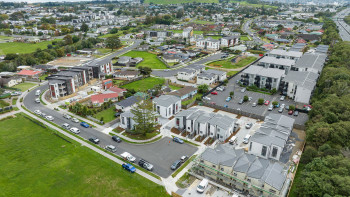Finding efficiencies in urban development
25 November 2024
Kāinga Ora is kicking off an initiative to drive down costs and achieve efficiencies for the delivery of urban development projects.
The organisation is working collaboratively with a number of organisations and agencies to achieve results benefitting the industry throughout Aotearoa New Zealand.
Mark Fraser, General Manager Urban Development and Delivery, says historically both public and private urban development practices in New Zealand have been inefficient and expensive.
“While organisations have, at times, managed to achieve improvements, often the impact is marginal because these improvements can’t be reflected across the wider system. As a collective, the industry hasn’t managed to deliver change that has made significant or enduring impact,” says Mark.
“Having a more consistent pipeline of work can help produce efficiency gains, but we need to look at the processes behind how the work is getting done, and that’s what we’re focused on.”
Using publicly-owned and strategically-acquired land, Kāinga Ora urban development teams plan, co-ordinate, integrate and deliver the infrastructure needed to enable a greater number of social and private homes. This infrastructure also future-proofs neighbourhoods by safeguarding them from future severe weather events and delivers popular public amenity for all to enjoy, such as parks and walkways.
Now, the teams are looking at how they can work with their partners to deliver this work in a shorter timeframe and at a lower overall cost.
 Initial baseline research conducted across the urban development system indicated current ways of working made it difficult to maximise productivity. The complexity of large-scale urban development meant there wasn’t a clear understanding around roles and responsibilities across the various agencies involved. A lack of consistency in the way work was managed also led to too much downtime, waste and rework.
Initial baseline research conducted across the urban development system indicated current ways of working made it difficult to maximise productivity. The complexity of large-scale urban development meant there wasn’t a clear understanding around roles and responsibilities across the various agencies involved. A lack of consistency in the way work was managed also led to too much downtime, waste and rework.
Kāinga Ora is now launching a pilot aimed at tackling these issues, starting with a focus on the neighbourhood planning phase – from the agreement of a precinct business case through to the delivery all design drawings, documentation and necessary agreements to enable a smooth and efficient detailed design and consenting phase. The pilot will be centred on the Mangere Development’s Ōtaki o te Wai neighbourhood.
Mark says the pilot started to take shape during two solution design workshops which ran over a total of 13 days, with 60 participants from Kāinga Ora, Auckland Council, LEAD Alliance, Chorus, Vector and the council-controlled organisations (CCOs).
“The collective knowledge and experience brought to the initial, and many subsequent, workshops enabled the group to create an initiative that has the potential to have significant and lasting impacts on urban development in New Zealand.
“The workshops enabled a greater understanding of processes, pain points and goals for each of the agencies and organisations involved in the urban development process. We identified exactly what each stakeholder needs to do their work and the interdependencies that exist between all work streams.”
Mark continues, “Each discipline or workstream involved within the Neighbourhood Planning phase, such as water or utilities, has now developed its own individual process map, and these have been knitted together into one end-to-end map to form the basis of the pilot.
“Early design work indicates this initiative could reduce the neighbourhood planning timeframe from three years down to 23 weeks.
“There has been genuine engagement and enthusiasm from external partners as part of this mahi; it’s really encouraging to see people are now focusing on what is possible and being excited by what we can achieve together.”

